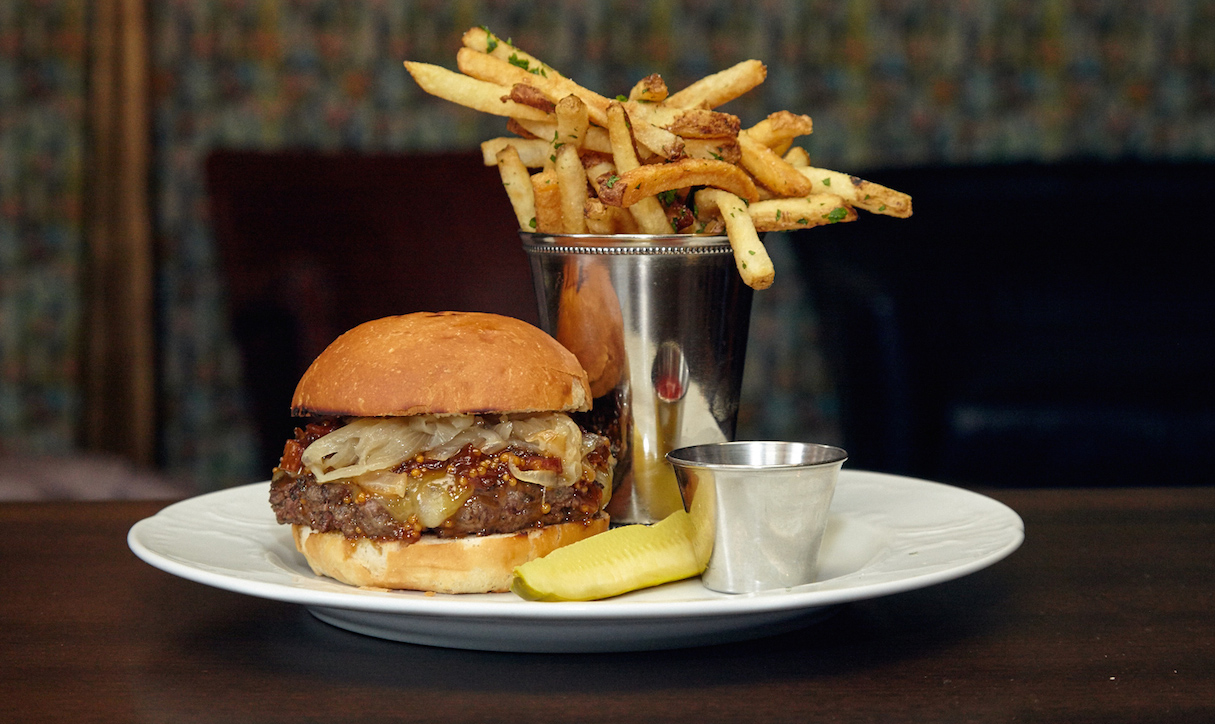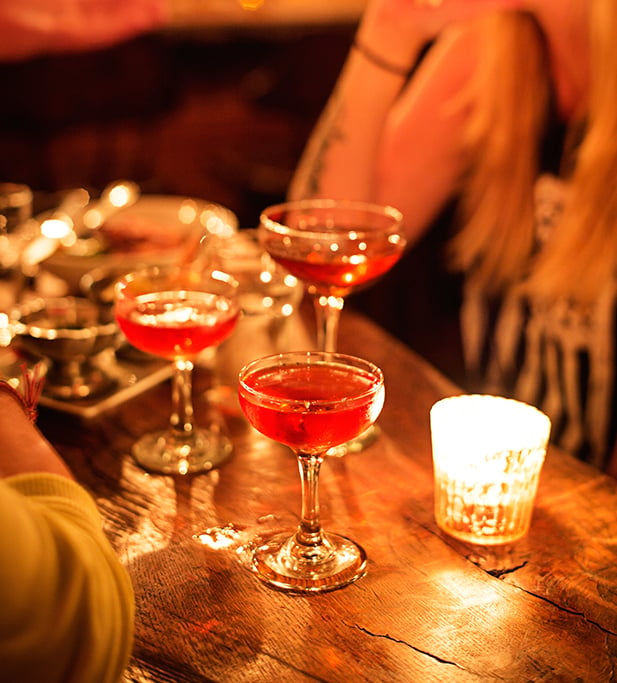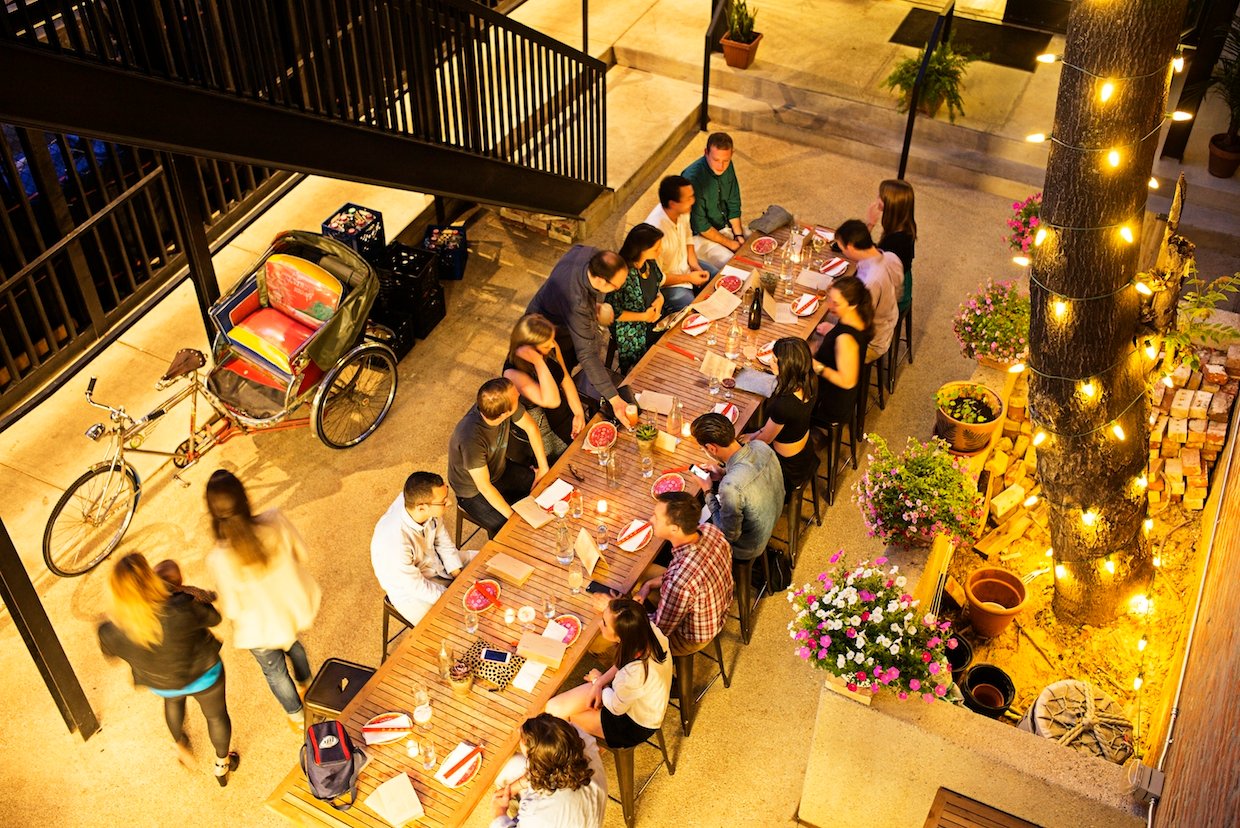Everyone knows how to read a menu, right? What could be simpler?

But do you know how to find the menu-within-the-menu? Do you know how to spot tendencies that might reveal a chef’s strengths? Can you identify slot-fillers?
In the inaugural installment of How to Read a Menu, I took apart the menu at the farm-to-table mom ’n’ pop Preserve, showing you the various codes that chef Jeremy Hoffman speaks in and why, and helping you to make more informed decisions as a result.
This week I want to try to deconstruct an entirely different menu—the one for The Riggsby, the second venture in the city for Boston-based, James Beard Award-winning chef Michael Schlow. Housed in the Art Deco-style Carlyle Hotel off Dupont Circle, the place is making a bold and interesting bid to separate itself from the hordes of loud, trendy, small plates spots (including Schlow’s own Tico).
The cooking emphasizes technique and coherence over novelty and flash. The waiters wear vests. The tables are set with white cloth. With more juice (and juice may yet come—The Riggsby has been open only since mid-summer), it’s not hard to imagine people invoking comparison to April Broomfield’s the Breslin and Graydon Carter’s Waverly Inn in New York, both of which are intended to evoke the glory days of Toots Shor, the iconic Manhattan saloon and restaurant beloved in the ‘40s and ‘50s by such drink-slinging swells as Sinatra, Dimaggio, and Gleason.
Note: Click on the highlighted menu items below to learn more about each item.
BAR SNACKS
HOMEMADE POTATO CHIPS
with green onion dip 6
In the first installment, I wrote about the notion of a menu-within-a-menu—a roster of dishes with which the chef hammers home his or her style or theme. In this case, a theme: the chef’s fondness for the sort of middle-class cocktail nibbles that were ubiquitous at dinner parties throughout the late ’60s and early ’70s. The greatest concentration of dishes from this menu-within-a-menu is to be found in the first half of the menu—actually, within the first six listed dishes, a sly and business-savvy move on the part of the chef, incentivizing you to order a “snack” before your appetizer and thus jack up the cost of your meal. The likelihood of finding something great is higher when you order from the menu-within-a-menu, and that would appear to be the case here: the deviled eggs with crisped chicken skin and the classic Caesar salad, in particular, are superb.
MARINATED OLIVES & ALMONDS 5
CHEESE & CRACKERS 7
Food isn’t like fashion; a dish doesn’t become ridiculous simply because no one eats it anymore; you don’t look back at memorable plates you ate 10 years ago and think, in horror—'I can’t believe I ate that!'
In the first installment, I wrote about the notion of a menu-within-a-menu—a roster of dishes with which the chef hammers home his or her style or theme. In this case, a theme: the chef’s fondness for the sort of middle-class cocktail nibbles that were ubiquitous at dinner parties throughout the late ’60s and early ’70s. The greatest concentration of dishes from this menu-within-a-menu is to be found in the first half of the menu—actually, within the first six listed dishes, a sly and business-savvy move on the part of the chef, incentivizing you to order a “snack” before your appetizer and thus jack up the cost of your meal. The likelihood of finding something great is higher when you order from the menu-within-a-menu, and that would appear to be the case here: the deviled eggs with crisped chicken skin and the classic Caesar salad, in particular, are superb.
DEVILED EGGS
with calabrian chilies and crispy chicken skin 5
Food isn’t like fashion; a dish doesn’t become ridiculous simply because no one eats it anymore; you don’t look back at memorable plates you ate 10 years ago and think, in horror—'I can’t believe I ate that!'
In the first installment, I wrote about the notion of a menu-within-a-menu—a roster of dishes with which the chef hammers home his or her style or theme. In this case, a theme: the chef’s fondness for the sort of middle-class cocktail nibbles that were ubiquitous at dinner parties throughout the late ’60s and early ’70s. The greatest concentration of dishes from this menu-within-a-menu is to be found in the first half of the menu—actually, within the first six listed dishes, a sly and business-savvy move on the part of the chef, incentivizing you to order a “snack” before your appetizer and thus jack up the cost of your meal. The likelihood of finding something great is higher when you order from the menu-within-a-menu, and that would appear to be the case here: the deviled eggs with crisped chicken skin and the classic Caesar salad, in particular, are superb.
JALAPENO TATOR TOTS 6
Food isn’t like fashion; a dish doesn’t become ridiculous simply because no one eats it anymore; you don’t look back at memorable plates you ate 10 years ago and think, in horror—'I can’t believe I ate that!'
In the first installment, I wrote about the notion of a menu-within-a-menu—a roster of dishes with which the chef hammers home his or her style or theme. In this case, a theme: the chef’s fondness for the sort of middle-class cocktail nibbles that were ubiquitous at dinner parties throughout the late ’60s and early ’70s. The greatest concentration of dishes from this menu-within-a-menu is to be found in the first half of the menu—actually, within the first six listed dishes, a sly and business-savvy move on the part of the chef, incentivizing you to order a “snack” before your appetizer and thus jack up the cost of your meal. The likelihood of finding something great is higher when you order from the menu-within-a-menu, and that would appear to be the case here: the deviled eggs with crisped chicken skin and the classic Caesar salad, in particular, are superb.
CHORIZO STUFFED MUSHROOMS 7
Food isn’t like fashion; a dish doesn’t become ridiculous simply because no one eats it anymore; you don’t look back at memorable plates you ate 10 years ago and think, in horror—'I can’t believe I ate that!'
In the first installment, I wrote about the notion of a menu-within-a-menu—a roster of dishes with which the chef hammers home his or her style or theme. In this case, a theme: the chef’s fondness for the sort of middle-class cocktail nibbles that were ubiquitous at dinner parties throughout the late ’60s and early ’70s. The greatest concentration of dishes from this menu-within-a-menu is to be found in the first half of the menu—actually, within the first six listed dishes, a sly and business-savvy move on the part of the chef, incentivizing you to order a “snack” before your appetizer and thus jack up the cost of your meal. The likelihood of finding something great is higher when you order from the menu-within-a-menu, and that would appear to be the case here: the deviled eggs with crisped chicken skin and the classic Caesar salad, in particular, are superb.
FIRST COURSES
OYSTER OF THE DAY
with spicy cucumber mignonette p/a
BUTTER LETTUCE
with shaved radish, walnuts, goat cheese & tarragon 11
CREAMY BURRATA
with summer tomatoes, good olive oil & bottarga 13
SHRIMP & CUCUMBER GAZPACHO
with jalapeño, cilantro & tiny croutons 11
SAUTEED CALAMARI
with tomato, olives, cranberry beans & parsley 12
CLASSIC CAESAR SALAD
with anchovies & shaved parm 11
Food isn’t like fashion; a dish doesn’t become ridiculous simply because no one eats it anymore; you don’t look back at memorable plates you ate 10 years ago and think, in horror—'I can’t believe I ate that!'
In the first installment, I wrote about the notion of a menu-within-a-menu—a roster of dishes with which the chef hammers home his or her style or theme. In this case, a theme: the chef’s fondness for the sort of middle-class cocktail nibbles that were ubiquitous at dinner parties throughout the late ’60s and early ’70s. The greatest concentration of dishes from this menu-within-a-menu is to be found in the first half of the menu—actually, within the first six listed dishes, a sly and business-savvy move on the part of the chef, incentivizing you to order a “snack” before your appetizer and thus jack up the cost of your meal. The likelihood of finding something great is higher when you order from the menu-within-a-menu, and that would appear to be the case here: the deviled eggs with crisped chicken skin and the classic Caesar salad, in particular, are superb.
SARDINES
with fennel, pine nuts, golden raisins & crispy bread 15
JIMMY'S SPECIAL "CHOPPED" HOUSE SALAD
with homemade thousand island dressing 12
Food isn’t like fashion; a dish doesn’t become ridiculous simply because no one eats it anymore; you don’t look back at memorable plates you ate 10 years ago and think, in horror—'I can’t believe I ate that!'
In the first installment, I wrote about the notion of a menu-within-a-menu—a roster of dishes with which the chef hammers home his or her style or theme. In this case, a theme: the chef’s fondness for the sort of middle-class cocktail nibbles that were ubiquitous at dinner parties throughout the late ’60s and early ’70s. The greatest concentration of dishes from this menu-within-a-menu is to be found in the first half of the menu—actually, within the first six listed dishes, a sly and business-savvy move on the part of the chef, incentivizing you to order a “snack” before your appetizer and thus jack up the cost of your meal. The likelihood of finding something great is higher when you order from the menu-within-a-menu, and that would appear to be the case here: the deviled eggs with crisped chicken skin and the classic Caesar salad, in particular, are superb.
To call a dish “special”—to say, in effect, “this is great and memorable”—before you, the diner, have had a chance to render a judgment one way or another is a pretty gutsy move. I admire the chef’s risk-taking. The dish, though, sounds like the opposite of bold: a chopped salad with crisped bacon, hardboiled egg, green beans, and Thousand Island dressing. Is this a case of a chef trying to hype a modest dish, to draw attention to an item that you might otherwise miss? Or of a chef telling you that this is a legitimately knock-out preparation, a stunning example of salad-making craft? Even before sampling the dish for purposes of this review, I was inclined to think that it was unlikely to meet my elevated expectations: Tasting only confirmed my suspicions. Pass. (Note that this dish is not a “special.” That’s a different category altogether. Most specials are not special; most are about the kitchen getting in a product it doesn’t ordinarily use and turning that into a dish, which can sometimes be good, but generally the kitchen staff hasn’t had the repetitions necessary to nail it every time during the heat of dinner rush.)
BEEF CARPACCIO
with shaved mushrooms, frico chips, lemon & arugula 16
MUSSELS "MARINIERE"
with shallots, butter & chives 13
LIGHTLY SMOKED TROUT
with beets, horseradish & mache 12
ENTREES
ALL AMERICAN TAVERN BURGER
with bacon-onion jam, cheese & french fries 15
SEARED SCALLOPS
with mushrooms, onions & peas 28
GRILLED SHRIMP
with sardinian cous cous, green olives, almonds & red pepper-harissa broth 25
BARREL CUT NY STRIP FILET
with Phillipe's "super frenchy" bearnaise and homemade french fries 38
WILD STRIPED BASS
with summer corn, bacon and pickled onions 28
HERITAGE FARMS PORK CHOP
with hot cherry peppers, sausage, onions & potatoes 26
SCHNITZEL "A LA HOLSTEIN" 29
SLOW COOKED SALMON
with zucchini, artichokes, capers, lemon & chives 24
ROASTED CHICKEN
with broccoli rabe, roasted potatoes & mustard 26
FRESH SPAGHETTI
with Italian bacon, onion, tomato & pecorino 19
One of the things that makes this menu unusual is that there aren’t any obvious slot-fillers. This may be attributable to the throwback theme; the restaurants of the Toots Shor era made few, if any, concessions to the dietary needs and whims of their customers. There is, for example, no clear reach-out to vegetarians—and this in an era when many restaurants have begun to emphasize vegetables and/or stud their menu with dishes that can easily be made meatless (cf., Rose’s Luxury). In all likelihood, the fresh spaghetti can be made without bacon, but the restaurant hasn’t thought to alert diners to that fact. Whether intentionally or unintentionally, the chef has said, in effect: I have struck a reactionary blow for the dining of the past, the simpler, meat-centric, substitution-less past.
HERB AND PEPPER-CRUSTED COTE DE BOEUF (FOR 2)
with potatoes, asparagus & red wine sauce 89
SIDES
HOMEMADE FRENCH FRIES
with sea salt & herbs 6
CREAMY POTATO PUREE 7
HARICOT VERT
with shallots & butter
BROCCOLI RABE
with olive oil, garlic & chiles 8
GRILLED ASPARAGUS
with pecorino & black pepper 8
Otherwise is Washingtonian food critic Todd Kliman’s weekly column. Sometimes, it's about food.

















